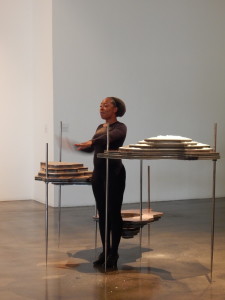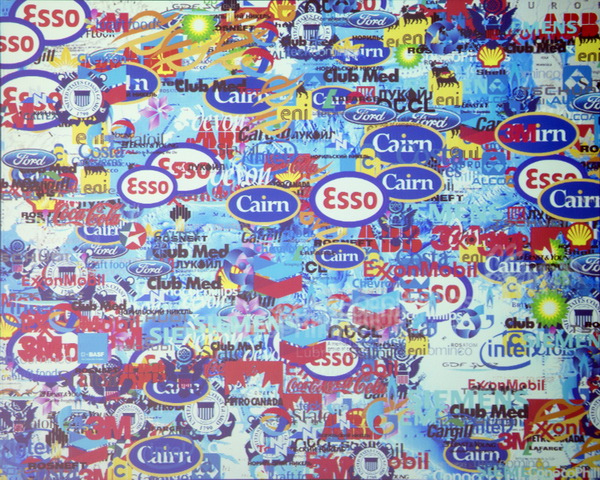The international group of artists in “Beyond 2°” question the multidimensional impact of natural resource exploitation, in distinct cases, in different global locations, and in damning portraits of corporate gain at the cost of human rights and the environment. The exhibit darkens parochial optimism in presages of global warming at a catastrophic 2° Celsius+.
In a departure from her work on Mexico and modernity, Melanie Smith’s video installation Fordlandia (2014) depicts—and is titled after—the failed and abandoned Ford rubber plant in the Amazon, its ruins covered by a fecund jungle. Ford’s attempt at resource domination is a ghostly symbol of capitalism in vain—according to Greg Grandin, not a drop of rubber ever made it from Fordlandia into an automobile.
“Beyond 2°” engages similar questions as FotoFest 2016 “Changing Circumstances: Looking at the Future of the Planet,” but whereas the FotoFest biennial amplified the beautiful to subtly portray the dreadful, “Beyond 2°” presents noisy and multisensory works at full tilt. For example, Ursula Biemann and Paulo Tavares’ Forest Law (2014), a two-channel video installation, engages Ecuador’s indigenous-led movement for ecosystem rights; Nicholas Mangan’s Progress-in-Action (2013) combines a hydraulic jack, audio, video and acid-etched copper plates to deconstruct the 1980s–’90s conflict between indigenous landowners and copper mining companies on the Pacific Island of Bouganville; Olga Kisseleva’s Arctic Conquistadors (2010–15), a map of the Arctic that, by design, layers corporate logos like Esso and Exxon, registers social and economic powers that have branded the landscape.
Kisseleva’s work engages the arctic as new territory for conquest; as ice melts, geo-political powers like the U.S., Russia and China, along with global conglomerates, compete for control of the region’s resources. The proliferating logos are boundless, extending far beyond the screen: in the immediate periphery, during “Beyond 2°”’s run, the Plains All American Pipeline was indicted on 46 charges for the 2015 Refugio State Beach oil spill.

Otobong Nkanga, performance of Solid Maneuvers at Museum of Contemporary Art Santa Barbara, May 18, 2016.
“Beyond 2°” cleverly balances imposing pieces with quieter ones that offer subtle lines and nuanced textures. In the airy Sonic Antarctica (2009/2016) by Andrea Polli, video taken at a research station at the South Pole is projected onto a translucent white tent. In one instance, raindrops appear on one side and on the other a vehicle slowly plows through the thick snow plane. Inside, it is an immersive environment, with sleeping bags for supine viewing and headphones to hear field recordings. Through the visual field all cultural markers vanish, the soundscape is calm and lonesome: ice pouring and staticky conversations among scientists. Here it is not a community subsumed by nature, as in Fordlandia; rather, it is the individual, immersed in an intimate vision of dissipating into the white snow, into what Rebecca Solnit has described as “the blue of distance.” Polli’s piece strikes a chilling tone, exposing the ephemeral quality of the human experience, also brought to the fore in Robert Zhao Renhui’s A Guide to the Flora and Fauna of the World (2013), photographs of small creatures and plants with subtle mutations; and in Amie Siegel’s RM#1-21 (2014), photographs of radioactive minerals found in derivatives of uranium, which, glowing against a pitch-black background, make visible the haunting effects of the mining industry’s confluence with the military.
In satellite images adhered to the gallery floor, Carolina Caycedo’s Yuma Cachuma (2016) considers two dams in a global–local critique—Colombia’s El Quimbo Dam, whose rerouting displaced the region’s indigenous population; and Santa Barbara’s Bradbury Dam, which created Lake Cachuma, a major source of water for the area, but also the cause of many dwindling species, such as Steelhead, which in times of drought, cannot pass the dam to reach spawning areas. Yuma Cachuma registers the collective complacency to environmental consequences of public works in the heedless footprints of gallerygoers.
Otobong Nkanga’s sculpture-cum-performance, Solid Maneuvers (2015), addresses the toxic aftermath of mining in northern Namibia. The sculptural element references the geological features of the now depleted mine—stacked slabs of metal (stand-ins for bronze, silver and gold), supported by rods, appear as if raised floating above the ground, disconnected from the earth. Minerals and fine powders fill depressions on the sculpture’s surface. In her performance, the artist uses spoken word and clockwork-like body movement until the fine brown powder covers the artist, and the distinction is blurred between mined material, body and machine.
The looping effect of “Beyond 2°’s” video and audio, endlessly repeating over time, deep into the dystopia of the morphing of the natural world, registers dark marks of nature’s exploitation, echoed around the globe in an endless pattern.



















0 Comments